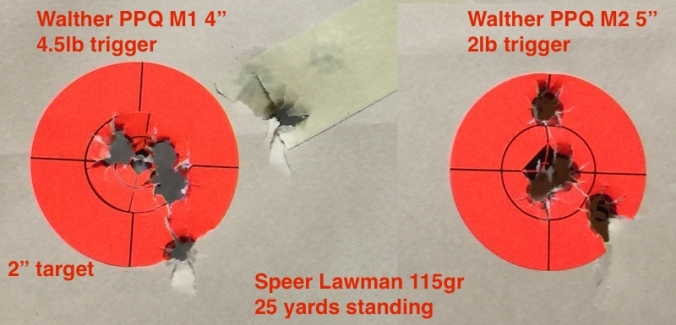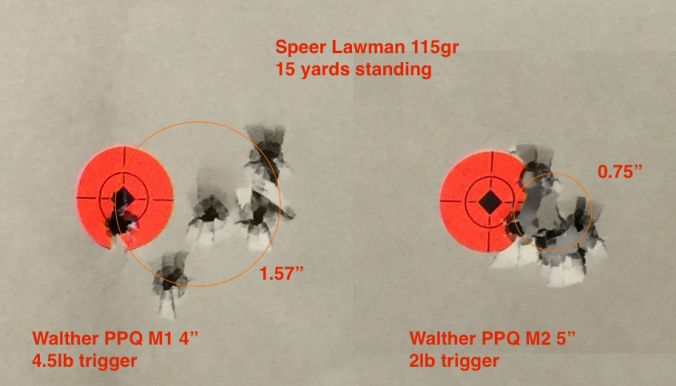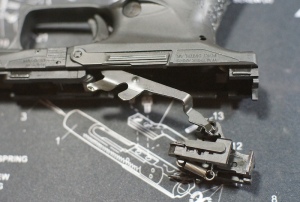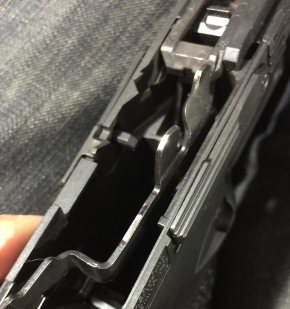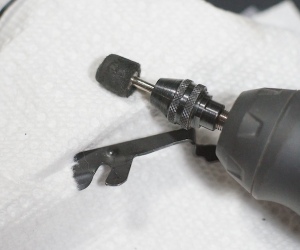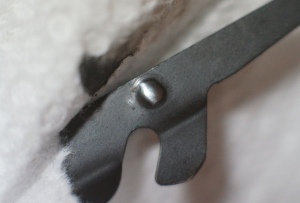This blog explores the reasons for the Walther PPQ’s great trigger and explains why PPQ has such a short trigger reset.
 The Walther PPQ had received great reviews and a keen following as the great successor of the already solid P99 pistol. I too, am one of the many owners impressed by the PPQ. Though the flip on this pistol was high, the PPQ was surprisingly accurate, and the trigger easily lived up to the hype. I opened up the pistol and was very impressed by how elegant its design was, and at the same time, noticed the potential for this pistol to have a light trigger that most hammer fired pistol couldn’t achieve. I thought this was what the new breed of striker fired pistol was all about.
The Walther PPQ had received great reviews and a keen following as the great successor of the already solid P99 pistol. I too, am one of the many owners impressed by the PPQ. Though the flip on this pistol was high, the PPQ was surprisingly accurate, and the trigger easily lived up to the hype. I opened up the pistol and was very impressed by how elegant its design was, and at the same time, noticed the potential for this pistol to have a light trigger that most hammer fired pistol couldn’t achieve. I thought this was what the new breed of striker fired pistol was all about.

With all the hype behind the VP9, I was happy to be part of the hype and be the owner of such a great looking pistol. At the range, the VP9 was very soft shooting, and accuracy was there. What bothered me was an uneven pre-travel, and the take up was much tougher than the pre-travel. It’s a feeling I get with most hammer fired pistol.
After opening up the VP9 and looking through the VP9’s sear group, I noticed distinct similarities towards VP9’s sear and the internals of other striker fired pistols such as Glocks. I tried lightening up the VP9’s trigger but quickly realized that I couldn’t do much without having to tune with the sear engagement angles and grind away metal.
The internals of both pistols are vastly different.
Since then I’ve decided to take a few photos to illustrate my findings between the two pistols. Hope it’ll be useful or interesting for those of you who are curious.
The PPQ pistol
So let’s take things apart and go through the inner workings of both pistols:

The whole sear group comes off with the removal of one spring pin. The sear group is actually very simplistic, yet different than most of the typical “hammer/sear” relationship.
Update – turns out this simple design for a sear housing is patented (https://www.google.com/patents/US7472507)

Here is the sear responsible for locking the striker. The top arm (more like a hook) of the sear locks the striker in place, but that isn’t the sear’s engagement surface. Instead, the right arm of the sear holds the sear engagement surface, and a separate lever swings back to release this sear. This setup is made so that the pivot point of the sear is behind the direction of the striker’s force. This simple design allows the sear itself to not take the blunt of the force from the striker pin.
Here are some observation on how the PPQ’s sear group works:

- With this design, the sear only takes in 1/3 of the striker’s force.
- The striker spring on the PPQ measured about 7.5lb.
- The striker’s contact with sear arm is 10mm away from pivot at an angle of 30 degrees
- This translates to 3.7lb being applied as torque on the sear arm itself (7.5lb x sin(30)), the rest of the force is decompression force handled by the sear’s joint
- The sear itself is sitting further away from the pivot, giving itself more mechanical advantage hence less force being applied at the engagement area. (10mm/17mm * 3.7lb)
- We have a striker at 7.5lb but at the sear, only 2.5lb of force is being applied, and assuming a friction coefficient of 0.16 for a lubricated polished steel surface**, the force it takes to move the sear’s lever is about 0.4lb
- With the trigger arm hitting the sear lever at around 10mm away from the pivot point and the sear engagement surface being at 13mm, it would take 0.6lb of force for the trigger arm to push disengage the sear lever.
** source for info (http://www.engineeringtoolbox.com/friction-coefficients-d_778.html)
The above observation got to have some mistakes or over-sight as I’m no physics major, but I hope it help illustrate how the general system works, and it’ll help make the comparison with the VP9 sear much easier.

Another easy way to see how much force is applied to the sear itself is to pull the trigger without the striker. It takes 4.6lbs to fire my PPQ normally, and with the slide taken off, the trigger return spring and sear return spring contributes 4.0lbs of the trigger pull. Meaning it takes only 0.6lb to break the sear.
This is the secret sauce to the PPQ’s short trigger reset – it is the only pistol where the trigger has a mechanical disadvantage towards pushing the sear lever. The result is a short travel on trigger to break & reset the sear with sacrifice to trigger weight. Other pistols need a mechanical advantage because their sears are so heavy.
Update – Walther holds a patent for this particular design (https://www.google.com/patents/US5701698)
Now on to the VP9
The VP9 requires a little bit more effort to have the sear assembly removed. Besides the spring pin that holds the sear group in place, you also need to remove the slide release lever, and a spring pin that holds the trigger assembly in place. Wish it’s a bit more straight forward to maintain.

Similar to other HK pistols, the VP9’s trigger bar also ride along the bottom edge of a guide rod which is the disengage rod. It makes the trigger rod move up then down during the up take. I mention this cause this part seem to add a tiny bit to the trigger weight, and it also causes a uneven trigger pull, which is not preferred for me as a shooter.

Now for the sear assembly.

Here we have an L shaped arm whose function is to move the sear by transferring the horizontal force of the trigger arm to a downward force for rotating the sear downward.
The sear itself is a more common design that resembles a Glock pistol. Primarily the sear’s pivot point is in front of the striker’s sear, and the sear engages head to head with the striker directly. Other striker fire pistols including M&P Shield, LC9s, P320, XDM, SD9, Sigma, all carry the same principle.
Here are the observation on how VP9’s sear works:

- The sear is taking in 9+lb of force even though the striker is pushing at 7.8lb
- The striker spring on the VP9 measured at around 7.8lb.
- The striker’s contact with the sear is the engagement surface itself. Therefore there are no mechanical advantage in play to reduce the friction placed on the sear’s engagement surface.
- The force needed to break the sear is the friction coefficient times the angular force from the striker, plus the force needed to push the striker backwards because the sear is sitting 11 degrees above the sear’s pivot point.
- Angular force is 7.8 x cos(11.7) = 7.63
- Striker’s push against rotation of sear is 7.8 x sin(11.7) = 1.54
- The total force on the sear’s engagement surface is 9.17lb, and if we assume a friction coefficient of 0.16 results in 1.42lb of rotational force required to break this sear.
- In the illustration above I raised the friction coefficient to 0.17, and it still didn’t result in the actual trigger pull force on the VP9. Probably the angle of the sear engagement surface causes more friction than what I calculated.
This whole design strikes me as someone who wish to derive a hammer firing pistol’s design through a striker system. The funny thing is, newer HK hammer firing pistols such as the P30 actually breaks that tradition and taking the sear engagement surface away from the hammer. Unless Walther holds a patent with how their sear works (update: they do), it’s odd that HK would go with this design.

It takes 1.7lb from the trigger to break the sear on the VP9. My VP9’s trigger is at 4.7lb, while without the slide, the trigger is at 3lb. But you get the idea. This setup of having a sear with such heavy force against it means you must be a wizard as a gunsmith to grind and polish your way to having a light trigger.
Glock pistols actually have a trigger connector which allows trigger weight to be adjusted, though at the expense of increasing the creep because that design creates a mechanical advantage from the trigger bar directly.
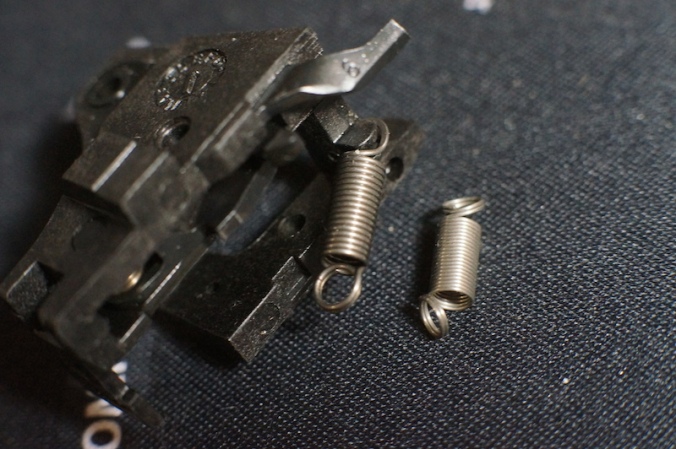
The PPQ on the other hand, allows for adjustments to trigger weight and creep independently. Read this article on how to add creep adjustment on your PPQ.
To adjust the trigger pull weight requires one simple spring change. Both mods are easy to perform and reversible. Upon realizing the gun’s brilliant design, and also it’s impressive accuracy, I purchased a second PPQ in with the M1 frame.
At the end of the day, I do love my VP9 because it’s still the best looking polymer in my opinion, and the ergonomics is terrific, while being one of the softest shooting polymers I have. I have plenty of guns whose accuracy doesn’t come close to the VP9. HK did a good job with introducing the striker fired VP9, and I hope that they would rethink their sear design in later models. As it stands, the PPQ’s sear group is by far more adjustable and potentially longer lasting. I have yet found another pistol that shares the PPQ’s sear design.
Here’s a link to other PPQ related posts – https://lanzerbot.wordpress.com/category/ppq/


